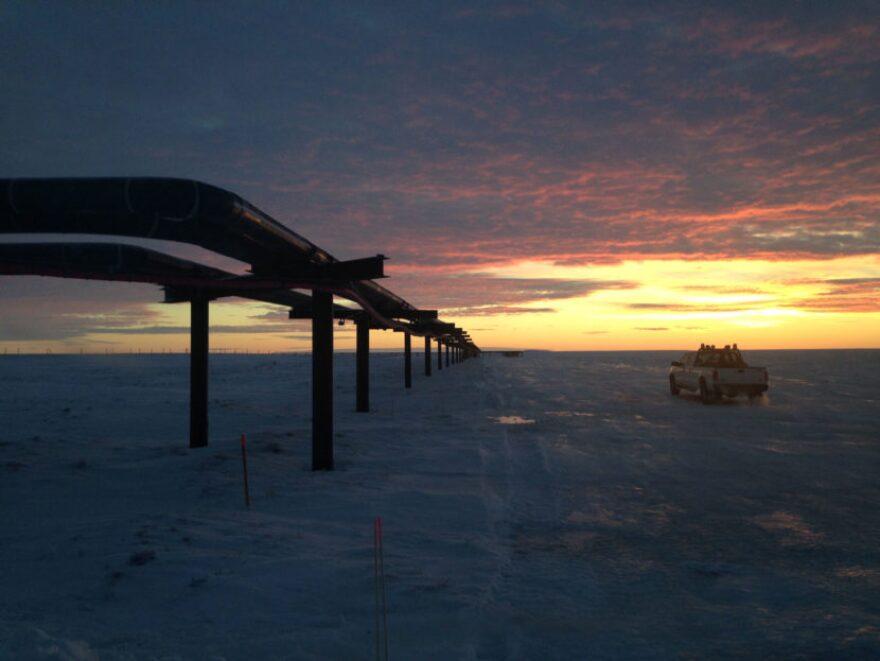For the first time ever, prices for a key U.S. oil benchmark went into the negatives on Monday.
The rapid crash of West Texas Intermediate crude is linked to the intricacies of the so-called futures market and a Tuesday deadline. It underscores the volatility in prices as the coronavirus pandemic crushes demand and storage capacity dwindles.
“This is an unprecedented event in the oil market,” said Dan Stickel, chief economist for the Alaska Department of Revenue. "There's an extreme oversupply and an extreme curtailment of demand and it's led to significant volatility in pricing."
While crude prices have continued to plummet in recent weeks, and oil companies have announced spending cuts, Monday’s price meltdown for the Lower 48 benchmark was particularly staggering.
“I almost didn’t believe the headline. Like, ‘What? How is that possible,’” said Kara Moriarty, chief executive of the Alaska Oil and Gas Association. “It’s this massive convergence of some crazy world dynamics that no one anticipated.”
Related: ConocoPhillips cuts spending in Alaska by another $200M as oil prices sink
The price of a barrel of West Texas Intermediate for May delivery sunk far below $0 on Monday, collapsing to almost negative $40. That effectively means sellers must pay that much to have someone take the crude off their hands.
It was unclear late Monday what price Alaska North Slope crude would close at. The Department of Revenue typically posts the price a day later.
Stickel, however, cautioned that Monday’s negative prices may not heavily impact Alaska oil producers, who sell most — if not all — of their crude farther in advance because of their distance from the market, and are already focused on June deliveries.
“They've already firmed up their May plans and they're saying, ‘Okay, where are we going to sell our oil production in June?’” Stickel said.
BP and Exxon also have their own refineries, said Larry Persily, a long-time observer of the oil and gas industry.
“Today's panic prices are not reflective of what Alaska North Slope producers are going to get for what they're delivering to their West Coast refineries this month,” Persily said. “But it’s still a kick in the head for the entire industry.”
Alaska North Slope crude prices have also already fallen from about $70 a barrel at the start of the year to $15.42 on Friday, nearly $3 under West Texas Intermediate on that day and the lowest price in more than 18 years.
“At current prices, the producers in Alaska are not covering their costs of operations,” Stickel said.
Production taxes and royalty payments in Alaska are based on the monthly average of the prices, he said.
At a Monday evening news conference, Gov. Mike Dunleavy described the plunging oil prices as stunning and another challenge for Alaska. Oil is the backbone of Alaska's economy and fuels the state budget, he said.
"We expect oil prices to rebound, but we don't expect necessarily to see them at the price that Alaska needs to balance its budget," he said.
Related: The coronavirus pandemic is devastating Alaska’s budget, and it could cost you your PFD
Monday’s oil free fall is nuanced, and has to do with a specific contract for a specific supply of oil.
The contracts for the May delivery of West Texas Intermediate crude expire Tuesday. Traders who have waited until the last minute to unload the contracts are desperate to find buyers.
And supply is far outpacing demand as the coronavirus pandemic keeps people at home. They're driving cars less often. They're not taking flights. Concerns continue to mount about the shrinking storage capacity for the oil that's being produced and not used — a glut that the oil price war also helped create.
"If you've got a contract... you're just going to get out and take your losses because you sure as hell really don't want physical delivery of that oil," Persily said.
Persily said he doesn’t expect the negative prices for West Texas Intermediate crude to last long. The June delivery price was just over $20 a barrel on Monday, still low but not below zero.
Stickel said he expected the June delivery prices to better reflect the price of a barrel of oil.
“As far as the true value of Alaska oil, I think the June deliveries are what actually matter for the revenue that we're going to get and the money that flows back to the producers,” he said.
Still, Persily said, Monday's drop highlights the uncertainty in the industry, and the underlying problem remains: “There are millions and millions of barrels a day of production around the world that don’t have a buyer.”
Earlier this month, several nations ended the oil price war with an agreement to cut output, but the supply reductions haven't hit the market yet, Persily said.
Moriarty said she also has concerns about the impact the below-zero prices may have on financing.
“Even a futures price kind of chills the hearts of investors,” she said.
Read the latest coverage of the coronavirus in Alaska.
Questions surround what low prices will mean for oil production in Alaska. Persily said he expected Alaska to see long-term impacts as companies cut costs by spending less on exploration and developing new oil fields.
"So we're going to see a delay in that new production that we hoped would maintain the flow out of the North Slope," Persily said.
Update: The Alaska Department of Revenue reported the value of a barrel of North Slope Crude on Mondayat negative $2.68.
Reach reporter Tegan Hanlon at thanlon@alaskapublic.org or 907-550-8447.


